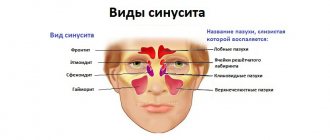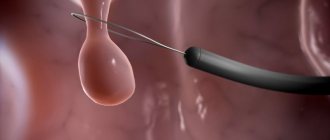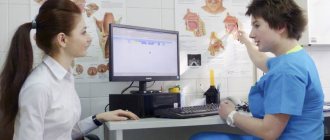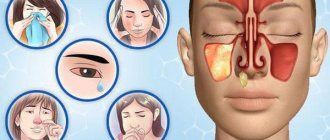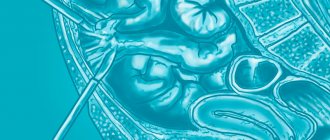Removal of nasal polyps is a procedure aimed at eliminating benign tumors of the nasal mucosa that make breathing difficult. The extent and complexity of surgery to remove nasal polyps depend on the location, number and size of the polyps. The reasons for the formation of polyps can be different: as a rule, they appear against the background of pathologies such as bronchial asthma, cystic fibrosis, rhinosinusitis of various natures (including allergic).
Outpatient nasal polypectomy - RUB 10,000.
Nasal polypotomy in the hospital - 56,000 - 90,000 rubles.
Included in the price:
surgery, consultation with an anesthesiologist, anesthesia, stay in a 2-bed ward, observation by the attending physician for a month after the operation.
15-40 minutes
(duration of procedure)
1 day inpatient or outpatient
Indications
- the presence of polypoid formations in the nose.
Contraindications
- heart failure;
- blood clotting disorder;
- acute infectious diseases;
- exacerbation of allergies, bronchial asthma.
General information about nasal polyps
Nasal polyposis is a disease characterized by an adaptive reaction in the form of hyperplasia (multiplication of tissue cells) of the mucous membrane in the nasal cavity and sinuses.
In addition to this cell proliferation, an edematous (fluid accumulation in the tissue) change in the affected area of the nasal mucosa may be present. Looking at the affected areas with an endoscope, you can see grayish-bluish growths. As a rule, pathological changes can be primarily detected in the area of the middle nasal passage, as well as the ethmoid sinus (ethmoid sinus), and the maxillary sinus (maxillary sinus).
Despite various scientific studies, it still remains a mystery why the inferior turbinate area does not tend to form polyps. In addition, the reliable pathogenesis of the formation of nasal polyps has not yet been identified. Of decisive importance in pathogenesis, apparently, is the association or interrelation of several pathological conditions that initially have no connection with the formation of polyps in the nasal cavity.
The goal of polypectomy is to restore the physiological function of the nose, and as a result provide adequate ventilation (patency) of the nasal cavity and adequate drainage (outflow) from the paranasal sinuses.
Why CELT?
The multidisciplinary clinic CELT is well known in the paid medical services market. We use exclusively modern, safe and low-traumatic methods of performing surgery to remove nasal polyps. They have the following advantages:
- no bleeding;
- Possibility of use in outpatient and inpatient settings;
- achieving the desired results.
We employ otorhinolaryngologists with extensive experience in polyp removal. They have at their disposal everything that is necessary for a successful operation.
Contraindications: who should be careful when removing polyps?
- General health – depending on the general somatic condition of the patient and the presence of concomitant pathologies, polypectomy can be performed under either local or general anesthesia. It is necessary to adequately assess surgical anesthetic risks and conduct preoperative preparation.
- Tendency to bleed . Inherited bleeding tendencies such as hemophilia (an inherited bleeding disorder) require special precautions to prevent serious intra- or post-operative complications.
How is surgery performed in our clinic?
The cost of surgery to remove nasal polyps in our clinic is affordable, since we pursue a pricing policy that is loyal to our patients. The method of performing the operation depends on the indications and contraindications and is determined by our otolaryngologist individually during a consultation.
The duration of the intervention depends on how widespread the process is. If we are talking about one polyp, the procedure is performed under local anesthesia on an outpatient basis and will last about 15 minutes. The presence of polyps in the paranasal sinuses will take longer and may last more than an hour. Polypotomy in a hospital is painless, as it is performed under anesthesia.
Preparing for surgery to remove polyps
- Preoperative therapy - Conservative treatment is usually carried out before surgery. To reduce recurrences of polyposis, it is advisable to administer steroid therapy immediately before the procedure. Typically, nasal emulsions and sprays (steroids) are used for therapy. In order to reduce the risk of bleeding during or after surgery, hemostatic drugs are often prescribed several days before surgery.
- Anticoagulants – Stopping blood thinning drugs such as acetylsalicylic acid should be done in consultation with your doctor. Stopping the medication for a short period of time significantly reduces the risk of rebleeding. If there are diseases that can affect the blood coagulation system, and they are known to the patient, this should be reported to the attending physician.
The main reasons for the formation of polyps
The development of the polyposis process occurs with concomitant diseases:
- Bronchial asthma. This disease has an “aspirin triad of symptoms”: PRS
- bronchial asthma
- intolerance to non-steroidal anti-inflammatory drugs.
Conservative treatment of polyps - pros and cons
For conservative treatment of nasal polyps, non-steroidal anti-inflammatory drugs and antihistamines are usually prescribed - which, unfortunately, do not have a significant therapeutic effect in the treatment of nasal polyps.
Despite the fact that the use of steroids is successful in more than half of the cases, this therapy is sometimes associated with side effects such as unwanted skin reactions and hormonal changes.
The side effects associated with systemic administration of hormones are relatively serious, so the initial use of steroids is prescribed only intranasally. It has been proven that the combination of polypectomy with traditional therapy reduces the dose of hormonal drugs.
Treatment of nasal polyps: is it necessary to remove tumors?
Considering the consequences of the development of the disease, and the feeling of constant inconvenience that it causes, the need to treat polyps is beyond doubt.
Today, medicine offers several methods for treating nasal polyps. Conservative therapy involves drug treatment to eliminate infectious inflammatory processes in the nasal respiratory tract, eliminating factors that provoke the growth of polyps, for example, exposure to allergens, also observing dietary restrictions, conducting regular rinses of the nasal cavity and performing special exercises. Hormonal medications may also be used for treatment.
Rejection of polyps can be achieved by heating them with a quartz lamp to a certain temperature.
Polyps are dangerous due to their complications - sleep apnea, exacerbation of asthma attacks, and the development of chronic sinusitis. Removal of polyps requires surgery, however, if conservative treatment methods do not help and the disease has reached advanced forms, surgery becomes a necessity.
Polypectomy
If conservative treatment does not provide a positive effect or chronic sinusitis is associated, polypectomy is the gold standard of treatment.
The main goal is the removal of polyps of the mucous membrane, and the possible restoration of the physiological function of the nose. The use of polypectomy has the main advantage of achieving an immediate improvement in nasal breathing.
And the modern use of endoscopic technology makes it possible to remove polyps, ensuring self-regeneration of the deep areas of the nasal cavity. It should be noted that this minimally invasive method is successful in maintaining the integrity of unaffected areas, especially in the early stages of the disease.
If there is already a tendency to relapse or the clinical symptoms are more severe, then the option of such minimally invasive therapy should be reconsidered. In addition to polypectomy, to achieve significant improvement, it is necessary to perform septoplasty and vasotomy in parallel with it, restoration of anatomical structures.
To assess the extent of polyposis and determine the extent of surgical intervention, it is necessary to perform nasal endoscopy and computed tomography of the sinuses in terms of preoperative examination.
Symptoms of nasal polyps: how to recognize the disease
The main symptomatology is characterized by difficulty in nasal breathing - a person experiences a feeling of constant nasal congestion, while not a single medicine in the form of drops, nasal ointments or tablets helps to cope with it.
Other manifestations include:
- increased production of mucus, sometimes with purulent impurities;
- frequent sneezing;
- the appearance of headaches;
- deterioration of the sense of smell when overgrown tissue interferes with the functioning of the receptors;
- the appearance of an unpleasant taste in the mouth if the polyps have reached large sizes;
- the appearance of nasality and changes in voice;
- the presence of polyps in the first year of a baby’s life can cause the development of malocclusion.
When the growth of polyps reaches the most advanced stage, a person, against the background of general nasal congestion and constant nasal discharge, feels malaise, weakness and increased fatigue.
Features of treatment in children
Polyps are more common in adults than in children. But in childhood, as with any chronic pathology, doctors show a minimum of radicalism in relation to treatment; surgical treatment takes a back seat. And if surgical intervention is still required, it will be minimally invasive. If the child is under 15 years old and polypotomy is indicated for him, it will be gentle - with a laser, radio waves, endoscope or shaver, without opening the paranasal sinuses.
Children are treated conservatively; treatment, in addition to the prescription of local and general medications, includes rinsing the nasal cavity using the displacement method. During the rinsing process, allergens and bacteria from the nasal cavity and paranasal sinuses are washed away, and inflammation is reduced.
What is the radio wave method of polyp removal?
Radio wave surgery is a modern, low-traumatic method of surgical interventions on soft tissues without destroying them. The effect of the cut is achieved using the heat generated by the resistance that tissues offer to the penetration of radio waves. The energy is concentrated at the tip of the electrode, and although the electrode itself does not heat up, molecular energy is generated inside each cell, which destroys and vaporizes the polyps.
The advantages of this method are:
- scarless wound healing
- analgesic effect
- radio waves also have a sterilizing effect
Rehabilitation after polypotomy
The postoperative period depends on the extent of surgical intervention performed on the patient. If a polysinusotomy was performed, the patient's nasal cavity is tamponed to avoid postoperative nosebleeds. In the case of endoscopic shaver or laser polypotomy without opening the sinuses, tampons are not needed.
Rehabilitation takes up to one week for any type of intervention.
With minimally invasive interventions, this period is reduced to 2-3 days, until the reactive postoperative swelling of the mucous membrane subsides. After surgery, it is recommended to limit physical activity for 2-3 weeks.
After surgery, topical steroids are prescribed to prevent the regrowth of polypous tissue. Patients with polypous rhinosinusitis should undergo a course of topical steroids several times a year.
Potential Risks
“Polypous tissue is initially non-cancerous. This is not an oncological pathology, but a benign formation. But at the same time, everything that will be removed in the operating department will be sent for histological examination, so that the doctor studying the biomaterial can give a clear answer to the question of what it is,” noted Vladimir Zaitsev. In addition, it will tell you how fast the growth rate is. This is the main thing. This indicator also determines what the effect of the operation will be, for example, whether the polyps will grow again. “It happens to one person that they removed them and the polyps grew back literally six months later. He may attribute this to a poorly performed operation, but in fact the problem is precisely the growth rate. And for some, after one operation they may not grow back. Everything is very individual,” says Vladimir Zaitsev.
Types of polyps.
The larger the formation, the more intense the symptoms. The most “harmless” are stage I polyps. They cover only the upper part of the nasal septum. Breathing is practically unaffected. At this stage, polyps are usually discovered by chance.
At stage II, the degree of polyp growth is much greater: it covers most of the nasal passage. At this stage, problems with nasal breathing begin, and discharge from the nasal cavity appears.
Stage III formation grows so much that it blocks the entire nasal passage. The patient simply cannot breathe through his nose. Breathing is done through the mouth. But this method does not cover the body’s oxygen needs, the patient suffers from headaches, gets tired quickly, plus the risk of viruses and bacteria entering the body with such breathing increases many times over.
Risk factors
All conditions that cause chronic inflammation of the nasal passages or sinuses (infections, allergies) increase the risk of nasal polyps. The following conditions are most often associated with polyps:
- asthma;
- sensitivity to aspirin;
- allergic fungal sinusitis, allergy to fungal spores;
- cystic fibrosis (or cystic fibrosis);
- Churg-Strauss syndrome (a rare disease that causes inflammation of blood vessels);
- vitamin D deficiency;
- Some genetic variations related to the functioning of the immune system may increase the likelihood of developing nasal polyps.
How to fight
There are two treatment options, notes the otorhinolaryngologist. The first option is surgical, when all polypous tissue is removed. The second option is conservative. “Special nasal sprays are used. But here it is important to remember that all therapy is exclusively under the supervision and as prescribed by a doctor,” says Vladimir Zaitsev.
Polyps are removed in different ways. If they are small and located in the vestibule of the nose, the operation can be performed in an ENT office. But when they are large and located deep, in the cells of the ethmoid labyrinth, a person can be put under anesthesia and removed in an operating room using an endoscope, says the ENT doctor.
Treatment must be carried out under the supervision of a doctor. “Unfortunately, if you compare a polyp and a cyst, the probability of malignancy of a cyst is very small, and the probability of malignancy of polypous tissue is very high, especially if there is a predisposition. Therefore, the polypous tissue is sent for examination,” says the otolaryngologist. And if a person does not act, there is a risk that the polyp will begin to grow deep into the brain tissue, which can lead to the death of the person in a fairly short time. Polyps cannot be treated with coolness; one must always be wary of them, the otolaryngologist sums up.
Prevention of polyposis process
The best prevention is timely consultation with a doctor and comprehensive treatment of diseases that contribute to the possible appearance of polyps. If a person experiences the slightest disturbance in nasal breathing, this should be a signal to action. Any disturbance in the structure of the nasal cavity and disruption of the air flow in it can contribute to the development of polypous rhinosinusitis. People with bronchial asthma should visit an ENT doctor at least once a year, undergo an endoscopic examination and, if necessary, have a computed tomography scan of the sinuses.
Complications due to untimely treatment of polyps
Firstly, complications are possible with bronchial asthma. If polyposis actively develops and polyps grow, attacks of bronchial asthma become more frequent and are much more difficult to tolerate. Secondly, this is a violation of nasal breathing, which has a bad effect on the entire body. Lack of oxygen leads to the development of chronic diseases. In this case, a person will quickly develop problems with the heart and lungs. Also, lack of oxygen leads to chronic fatigue and developmental delays (if the patient is a child).
Polyps contribute to chronic inflammation in the nasal cavity, rapid penetration of infection into the lower respiratory tract, and even a common cold can cause complications for a person with polyposis.
Very rarely, polyps can transform into malignant tumors. But in addition, there are diseases, such as inverted papilloma or other neoplasms of the paranasal sinuses, the symptoms of which pass under the guise of a polyposis process, carrying a significant threat.
It is recommended to consult a doctor and start treatment in the early stages of polypous rhinosinusitis, which will avoid complications and be cured without surgery.

